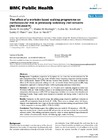| dc.contributor.creator | Murtagh, Elaine | |
| dc.contributor.creator | Murphy, Marie H. | |
| dc.contributor.creator | Boreham, Colin | |
| dc.contributor.creator | Hare, Lesley | |
| dc.contributor.creator | Nevill, Alan M. | |
| dc.date.accessioned | 2014-04-09T11:56:24Z | |
| dc.date.available | 2014-04-09T11:56:24Z | |
| dc.date.issued | 2006 | |
| dc.identifier.citation | Murphy, M .H., Murtagh, E. M., Boreham, C. A. G., Hare, L. G. and Nevill, A. M., (2006) ‘The effect of a worksite based walking programme on cardiovascular risk in previously sedentary civil servants’, BMC Public Health, 6(1), 136-143. | en |
| dc.identifier.uri | http://hdl.handle.net/10395/1995 | |
| dc.description.abstract | Background: A significant proportion of Europeans do not meet the recommendations for 30
mins of physical activity 5 times per week. Whether lower frequency, moderate intensity exercise
alters cardiovascular disease (CVD) risk has received little attention. This study examined the
effects of 45 minutes self-paced walking, 2 d· wk-1 on aerobic fitness, blood pressure (BP), body
composition, lipids and C-Reactive Protein (CRP) in previously sedentary civil servants.
Methods: 37 subjects (24 women) aged 41.5 ± 9.3 years were randomly assigned to either two
45 minute walks per week (walking group) or no training (control group). Aerobic fitness, body
composition, blood pressure (BP), CRP and lipoprotein variables were measured at baseline and
following 8 weeks. Steps counts were measured at baseline and during weeks 4 and 8 of the
intervention.
Results: Compared to the control group, the walking group showed a significant reduction in
systolic BP and maintained body fat levels (P < 0.05). There were no changes other risk factors.
Subjects took significantly more steps on the days when prescribed walking was performed (9303
± 2665) compared to rest days (5803 ± 2749; P < 0.001).
Conclusion: These findings suggest that walking twice per week for 45 minutes at ~ 62% HRmax,
improves activity levels, reduces systolic BP and prevents an increase in body fat in previously
sedentary adults. This walking prescription, however, failed to induce significant improvements in
other markers of cardiovascular disease risk following eight weeks of training | en |
| dc.language.iso | eng | en |
| dc.publisher | Biomed Central | en |
| dc.relation.ispartofseries | BMC Public Health;6(1) 136-143 | |
| dc.rights | Used with permission © from Biomed Central. | en |
| dc.subject | Health | en |
| dc.subject | Cardiovascular risk | en |
| dc.subject | Walking | en |
| dc.subject | Exercise | en |
| dc.title | The effect of a worksite based walking programme on cardiovascular risk in previously sedentary civil servants | en |
| dc.type | Article | en |
| dc.type.supercollection | all_mic_research | en |
| dc.type.supercollection | mic_published_reviewed | en |
| dc.type.restriction | none | en |
| dc.description.version | Yes | en |
| dc.identifier.doi | http://doi.org/10.1186/1471-2458-6-136 | |


